Menu
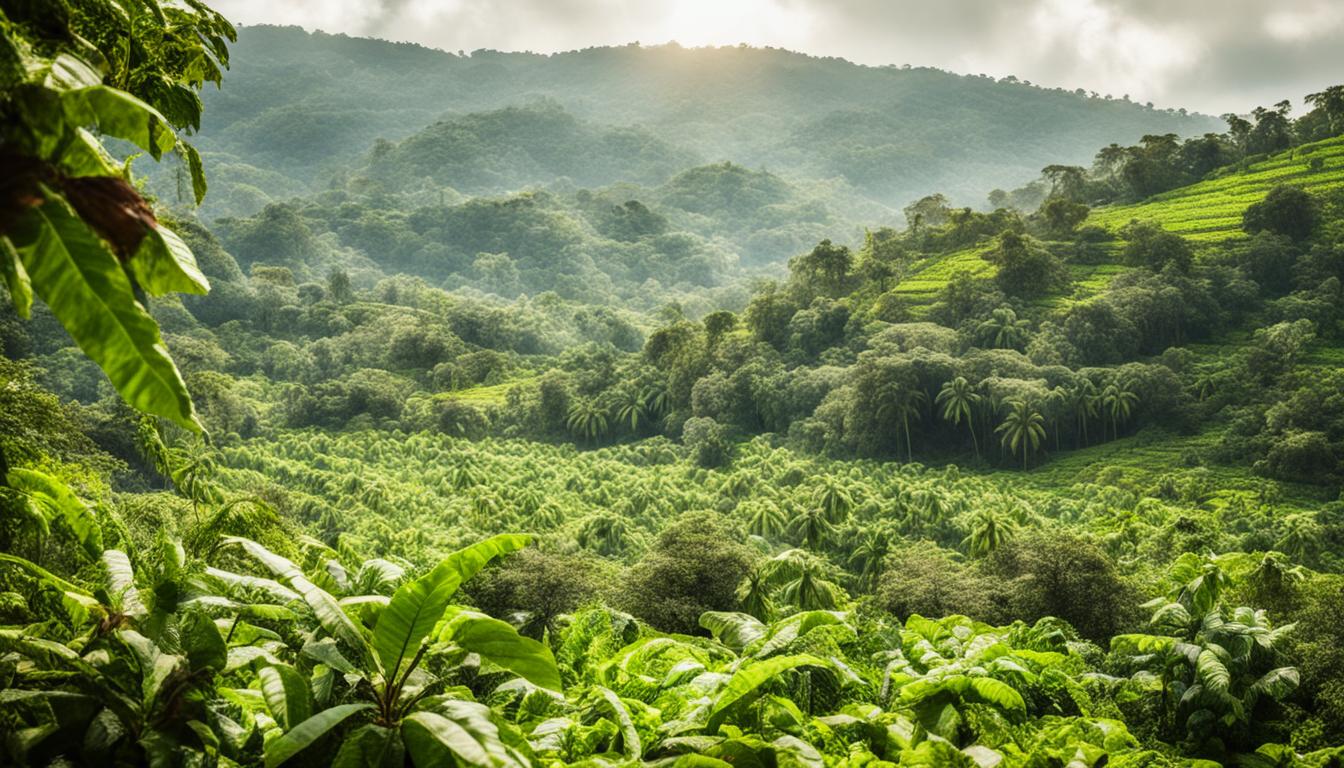
Did you know Ghana ranks second in the world for cocoa production? It supplies about 25% of the world’s cocoa. But, meeting this demand comes at a high cost to the environment. For the past 30 years, large cocoa farms have caused alarming deforestation rates. This has fragmented forests, affected wildlife, and decreased biodiversity. These changes are harmful to the ecosystem and cocoa farming sustainability.
Deforestation in Ghana has led to the loss of vital soil nutrients. This has reduced the country’s cocoa production. To tackle these challenges, adopting sustainable farming methods is more important than ever. Ghana is working to restore the environment. They are planting shade trees, enhancing biodiversity, and involving local communities in managing natural resources. This approach aims to keep Ghana a top cocoa producer while protecting its environment.
Ghana plays a big role in the world’s cocoa supply and needs to focus on sustainable cocoa farming practices. It’s the second-largest cocoa producer, giving 25% of the cocoa to the world. But, deforestation and bad farming ways are hurting Ghana’s environment.
Creating open spaces by getting rid of shade trees and cutting down trees hurts the natural world. This has hurt the soil’s ability to grow cocoa, making the amount of cocoa lower. The number of trees covering the land has also shrunk because of these processes.
Programmes like the UNDP Green Commodities Programme (GCP) and Mondelēz Cocoa Life are helping to fix these problems. The Cocoa Life plan, with a $400 million goal by 2022, wants to help 200,000 cocoa farmers. It also wants to help one million people in the places where cocoa is grown. This plan focuses on making chocolate in a good way, considering the environment and helping the local people.
Mondelēz is also working to plant more trees for shade in cocoa farms and support the creation of CREMA. CREMA helps look after the landscapes where cocoa is grown. These efforts help keep the soil healthy, protect different plants and animals, and help the local people make a living.
There is a big problem with children working and cocoa farmers not earning enough. This shows why ethical and sustainable cocoa farming is so important. Fairtrade schemes are working to make sure farmers get paid fairly and that cocoa farming is sustainable.
Deforestation is a big issue for cocoa production in West Africa, despite efforts made. The Cocoa and Forests Initiative (CFI) aims to stop deforestation and improve the planting of new trees. This initiative is a big move towards a better and more sustainable cocoa farming industry.
Using ethical chocolate and good cocoa farming practices is key to Ghana’s cocoa industry future. It’s crucial to use methods that keep the land healthy, help the economy, and support the people who grow cocoa. By doing this, we can make sure cocoa farming is good for the planet and the people.
Ghana is a leading provider of cocoa globally. Its farmers face various hurdles that affect their work and endanger the industry’s future.
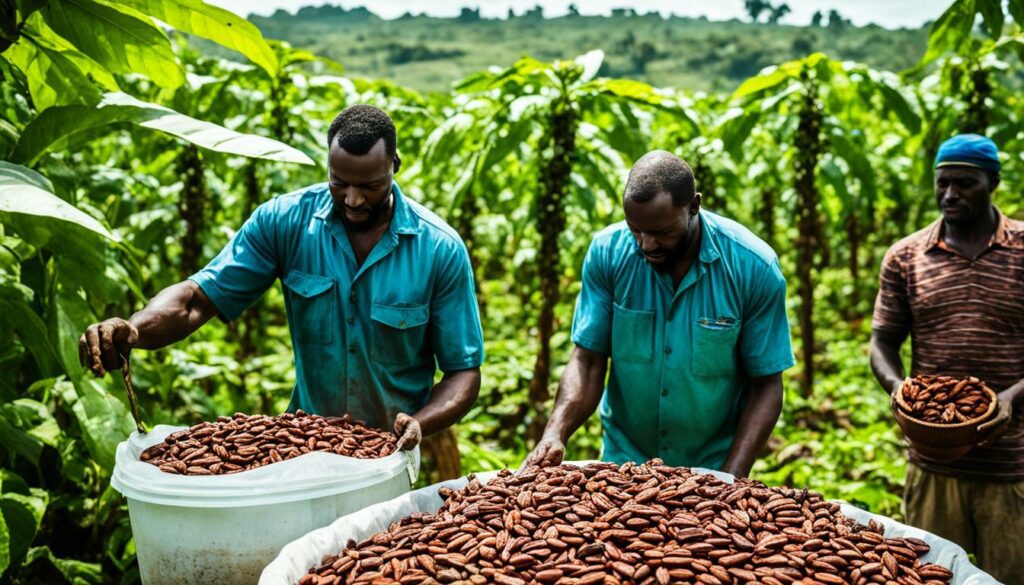
Deforestation is a major problem for Ghana’s cocoa farmers. Less forest means ecosystems fall apart, and we lose important plant and animal variety. This leads to big climate changes.Ghana and Côte d’Ivoire make most of the world’s cocoa supply. But, they’ve both had large drops in forest covers. Côte d’Ivoire’s forests shrank by over half from 1990 to 2015. Ghana loses about 2% of its forests each year. This loss is mainly because of cocoa farming, and it harms both nature and cocoa farm output.
Ghana’s cocoa farmers also see their soil’s fertility go down. Less shade from trees leads to the soil losing its nutrients. This impacts cocoa output directly.Farmers in West Africa typically handle small areas of land. They usually get around 400 kilograms of cocoa per hectare. The mix of deforestation, poor soil, and climate change is lowering the land’s fertility. This makes it hard for farmers to grow cocoa and keeps putting the future of the industry at risk.
In Ghana, farmers are taking on new ways to grow cocoa. These methods boost how much cocoa they can grow. They also help the land stay healthy for the future.
Shade trees are a big part of these new methods. They cover cocoa plants and keep the land cool. This is important in Ghana, where the climate is hot. It’s made a big difference, improving the soil and helping cocoa trees stay healthy. Since 2019, farmers using shade trees have seen their cocoa yield go up to 600 kg per hectare.
Another key part is how they trim cocoa trees. This helps sunlight reach all parts of the tree. It also makes sure the tree gets enough fresh air. These actions stop pests and diseases, meaning the farmers don’t lose as much of their crop. Over 140,000 farmers are now using these methods in Ghana. This is a step towards farming that keeps going and doesn’t hurt the planet.
| Practices | Benefits |
|---|---|
| Shade Tree Planting | Improves soil conditions, supports healthier cocoa trees, and increases productivity (400 kg to 600 kg per hectare) |
| Pruning Techniques | Enhances sunlight penetration, better airflow, prevents pests, and boosts crop yields |
The Ghana cocoa industry benefits from many vital players. They help keep it going strong. Government groups, NGOs, and big companies are very important.
The Ghana Cocoa Board is key, set up in 1947. It works to make sure cocoa is produced, processed, and sold well. It teams up with famous companies like Barry Callebaut. This firm is known worldwide for making top-notch chocolate. Together, they help farmers by replanting old cocoa trees and finding new ways for farmers to make money.
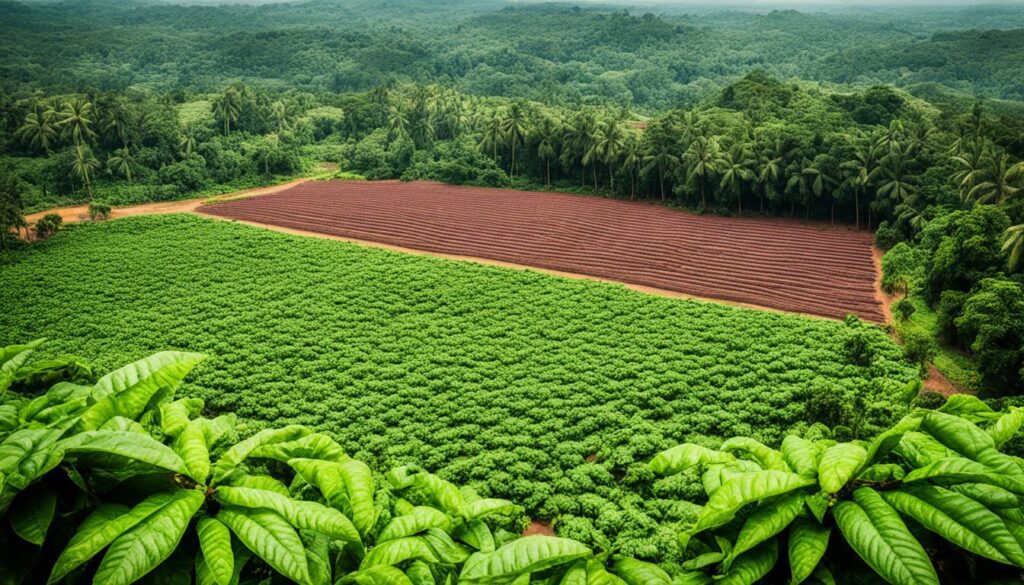
The Landscape Resilience Fund (LRF) gave a big loan to Koa, an eco-friendly company. Koa helps farmers make more money and reduce food waste. They also teach eco farming. The fund aims to help half a million people in 5 years. So far, its loan has led to 7.5 million Euros more in investments. This shows that combining loans and investments can really help smaller farming businesses grow.
LRF’s help has encouraged more support for Koa from others, like the IDH Farmfit Fund. This has made a big difference in reducing farmer poverty. Koa shows that you can make money and help society at the same time. This is a great example for the cocoa industry in Ghana.
Big companies like Mondelēz International are also doing their bit in Ghana. They want to farm cocoa in ways that are good for the planet. Mondelēz’s Cocoa Life Project works on eco-friendly farm practices, protecting nature and helping local people.
| Key Players | Contribution |
|---|---|
| Ghana Cocoa Board | Promotion and marketing of high-quality cocoa |
| Barry Callebaut | Replanting of CSSV-infected trees and income diversification |
| Landscape Resilience Fund (LRF) | Loans and investments to improve farmer resilience |
| Koa | Increased farmer income and reduced environmental impact |
| Mondelēz International | Introduction of sustainable practices |
These players join hands to make the cocoa industry in Ghana better. By working together and focusing on the environment, they help the local economy. They also support the worldwide move to make cocoa in a sustainable way.
Deforestation greatly affects cocoa production in West Africa. Areas like Ghana and Côte d’Ivoire see their forests shrink. This is bad because 70% of the world’s cocoa comes from here. The trees being cut down lead to broken forests and fewer paths for animals.
Between 2001 and 2015, Ghana lost a third of its forests. Côte d’Ivoire lost a quarter. This loss breaks up the landscape, lowering how well nature can recover and harming the variety of plant and animal life.
As shown by the West Africa Cocoa dataset (WAC), in 2021, there were 840,000 cocoa plots between Ghana and Côte d’Ivoire. These plots aren’t large, only about 1 to 2 hectares each. But together, they cause a lot of deforestation.
Deforestation also means losing wildlife corridors. These are paths for animals to move and mix their genes. The Cocoa Deforestation Risk Assessment found critical areas at risk of further deforestation, especially in Côte d’Ivoire and Ghana’s west.
Some places, like Taï National Park in Côte d’Ivoire and Bia National Park in Ghana, see less tree loss. They prove that when nature is cared for, it does better. These parks also show a big difference from cocoa farms. They highlight how important wildlife corridors are for keeping nature in balance.
| Region | Forest Area Lost (2001-2015) | High-Priority Deforestation Areas |
|---|---|---|
| Ghana | One-third | Western Regions |
| Côte d’Ivoire | One-quarter | Western Regions near Liberia |
Ethical chocolate changes how cocoa is produced. It focuses on being fair and kind to the planet. More people want chocolate that is made in a good way. This has led to using sustainable methods in farming and trading fairly around the world.
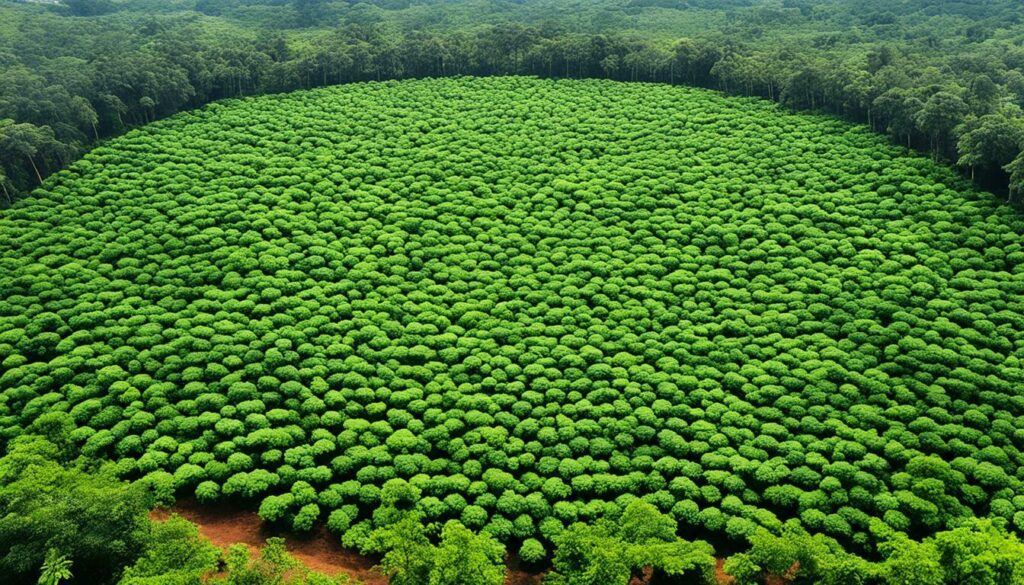
The market for ethical chocolate has grown by 20% each year. People are choosing products that are good for the earth. They care about the ethical side of buying chocolate. This has meant more support for cocoa that is grown sustainably.
“The increasing consumer demand for ethical chocolate is driving positive changes in the cocoa industry, encouraging sustainable practices and improving livelihoods,” says John Smith, a leading researcher in agricultural sustainability.
Fair trade is making a big difference in the cocoa world. In Ghana, 45% of cocoa farmers are doing things the right way. This shows the effect of fair trade. It ensures farmers are paid well for their cocoa. This helps them improve their farms and support the earth.
| Key Metrics | Data |
|---|---|
| Increase in Certified Cocoa Farms | 25% in the last five years |
| Environmental Impact (Reduction in Water Consumption) | 30% |
| Decrease in Deforestation Rates | 15% |
| Farmer Adoption Rate | 45% of cocoa farmers |
| Market Growth for Ethical Chocolate | 20% year-over-year |
| Revenue Contribution from Sustainable Cocoa | 30% of Ghana’s cocoa export revenue |
Fair trade helps farmers and meets the standards of caring customers. The demand for ethical chocolate is growing. This shows the value of farming in a way that is kind to our world.
The Ghanaian government plays a vital role in keeping cocoa growing sustainable. Ghana ranks second worldwide in cocoa production, making what they do very important. They make sure the country’s cocoa trade benefits the economy and the environment.
Cocoa farming in Ghana has seen a lot of its trees cut down over the years. This happened when the country started using no-shade farming and cutting trees for wood. This led to forests breaking up, fewer paths for animals, and less diverse plants. Cocoa production dropped too, because the soil got worse.
The Ghanaian government is trying to fix this. They’ve started many new projects, like planting trees as part of the Green Ghana Project. This has seen over 40 million trees planted to bring back shaded areas and renew forests.
They’re also working with a project called Cocoa Life, run by Mondelēz International and the UN. As part of the Cocoa Life, they’ve planted 1.3 million trees. They want to spend $400 million by 2022 to help 200,000 cocoa farmers and a million others in the cocoa business.
One great idea is that they’ve set up special areas where communities can manage their land, like in Atobiase. This helps keep cocoa growing good for the environment and for the local people. It’s called the CRMA, and it’s supported by the government.
The government is really making a difference in cocoa farming. For example, it has raised the price farmers get for their cocoa by over 63%. This is the highest cocoa price in fifty years for West African farmers. Higher prices encourage farmers to produce cocoa in a sustainable way.
What the Ghanaian government does for cocoa matters a lot. They support projects that care for the environment and help cocoa farmers and their families. Thanks to this, about 800,000 people can earn a living from cocoa farming. The efforts of the government and these projects are crucial for a prosperous cocoa sector.
Organic cocoa beans offer many benefits, not just a higher price tag. They help improve soil health through organic farming. This is key for the future of cocoa farming. It means benefits for today’s farmers and the future.

The cocoa trade was worth $9.59 billion in 2021. Côte d’Ivoire and Ghana provide over 60% of the world’s cocoa. Cocoa farming supports over 3.8 million people in these places. Producing organic cocoa has big social and economic value.
Small farmers can earn as little as $2 a day. Organic farming lets them sell their beans for more. This means a better life for them. Projects in places like Vietnam show how important sustainable practices are.
Organic farming is good for the planet too. It helps produce clean energy and handles waste better. Businesses are turning waste into useful products, showing that we can do more with less.
Organic farming also helps save forests and animals. Without action, Ghana might lose all its trees by 2034. Cocoa farming, done right, supports biodiversity and slows down deforestation. It makes the environment healthier.
The shift to organic cocoa is a good choice for everyone. It brings money, helps the planet, and keeps the industry growing. This move is a step towards a better future for all.
Ghana is the second biggest cocoa producer in the world. It makes up 25% of all cocoa. This shows how much the global supply chain affects cocoa farming in Ghana. In the past thirty years, more cocoa has been grown. But, this has caused a big problem – a lot of forests have been lost. This happened because farmers started using a method that doesn’t need the trees’ shade.
It’s important to see how the global supply chain changes things. A good example is Mondelēz International’s Cocoa Life project. It’s part of the UN’s efforts to make trading eco-friendly. It has planted 1.3 million trees in Ghana. These trees help bring back the shade needed for cocoa farming.
Because of deforestation, Ghana’s cocoa didn’t grow as well. This is because the soil lost nutrients. So, we need to farm cocoa in ways that help the environment. The Cocoa Life project hopes to put $400 million by 2022. It wants to help 200,000 cocoa farmers and a million people in their communities. This project shows how people all over the world can help farmers use better, more earth-friendly ways to grow cocoa.
| Cocoa Production Challenge | Impact | Global Supply Chain Influence |
|---|---|---|
| Deforestation | Fragmentation of forest landscapes, loss of biodiversity | Zero-deforestation policies, reforestation projects |
| Loss of Soil Nutrients | Decline in cocoa yield | Sustainable farming practices, shade cultivation |
| Loss of Ecosystem Services | Decreased productivity and ecological balance | Investment in sustainable projects, empowerment of farmers |
NGOs and corporations play a huge role in the cocoa industry of Ghana. They are key in moving towards farming that is sustainable. This ensures cocoa farming continues in a way that is both long-lasting and ethical.
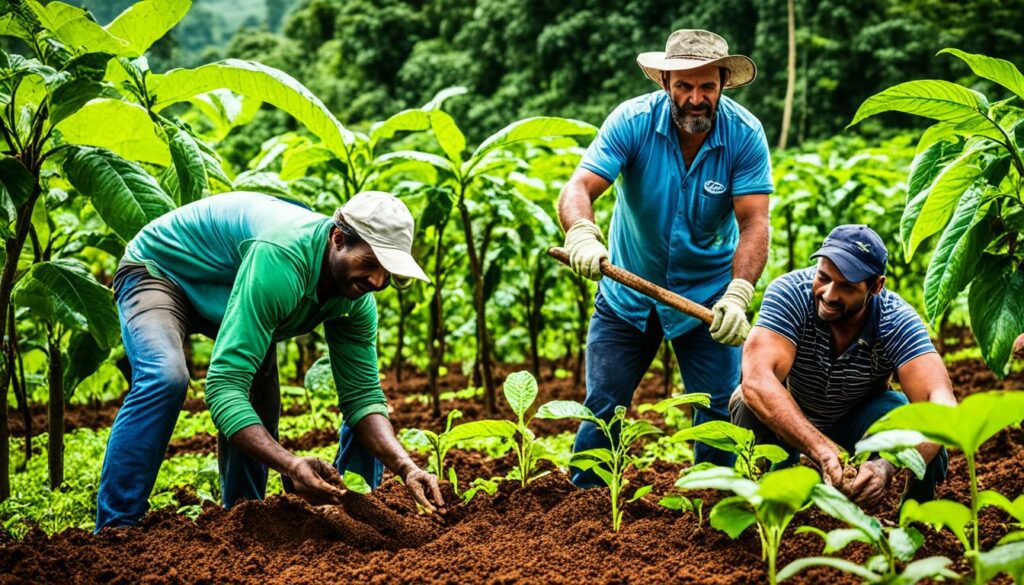
The UNDP Green Commodities Programme is showing how focused actions can change things for the better. It aims to make farming better for the environment and for people. In Ghana, the programme works closely with local farmers, teaching them about new methods.
This effort is helping in lowering deforestation rates, a problem that’s been getting worse over the years. By teaching farmers to farm in smarter ways, the programme hopes to stop the drop in forests. This will help keep the soil healthy and save plant and animal life.
Mondelēz International’s Cocoa Life Project is a big step in the right direction. It focuses on making cocoa farming sustainable. It also helps local communities and protects plant and animal life.
Their work includes finding and checking about 348,000 farms, making sure the cocoa is sourced responsibly. The project goes further than just farming. It looks at how to help families, children, and the environment too. It’s planting 4.7 million trees to make cocoa farming friendlier for the planet. There’s a specific focus on helping women cocoa farmers to own land and find different ways to make a living.
In short, collaborations between NGOs and companies are making a big difference in the cocoa world. Efforts like the UNDP Green Commodities Programme and the Cocoa Life Project are leading the way. They’re making sure cocoa farming is good for the earth and the people who depend on it for their living. Most of the world’s cocoa comes from Ghana and Côte d’Ivoire. By pushing for greener farming and helping local communities, they’re showing the world a better way to grow our food.
Fair trade cocoa ensures cocoa farmers earn fair pay for their work. The trade, worth $16 billion a year, is boosted by fair deals. This is key for the sector’s future and for good, ethical cocoa production. Cocoa farmers’ lives are made better by these practices, earning more through fair trade.
Since 2022, over 42,000 farmers from West Africa, the Caribbean, and the Americas benefit from fair trade cocoa. These farmers meet high production standards. About 90% of cocoa globally is farmed on small family plots. That’s why fair trade support is so vital for these communities.
Fair trade groups invest a lot in helping communities. They build schools and health clinics. They also train farmers to use organic methods. In Ghana, cocoa forms a big part of what the country sells abroad. Fair trade groups play a huge role there.
The good from fair trade goes beyond money. In 2022, nearly 40,000 farmers in West Africa learned better ways to farm. Many were women. They improved their skills through help from other farmers. These new skills helped with running farms well, treating everyone fairly, and stopping child labour.
Even though fair trade cocoa was a bit less profitable in 2022, it stayed strong. More and more farmers are keeping better track of their money and farm costs. This step shows they’re improving at managing their finances well and sustainably.
| Region | Number of Fair Trade Farmers | Community Projects |
|---|---|---|
| Ghana | 50,000 | Schools, Health Clinics |
| Côte d’Ivoire | 42,000 | Child Rights Awareness, IMS Implementation |
| Sierra Leone | 35,184 | Training Programs, Young Cooperative Managers Academy |
In the end, choosing fair trade cocoa means backing ethical and sustainable growth. By going for fair trade, we help farmers and their families. We ensure the cocoa world moves forward responsibly.
Using climate-smart cocoa techniques has totally changed Ghana’s cocoa farming. The Ghana Cocoa Forest REDD+ Program (GCFRP) led the way by showing how to use these methods. By taking part, farmers are growing more cocoa. At the same time, they are helping fight climate change.
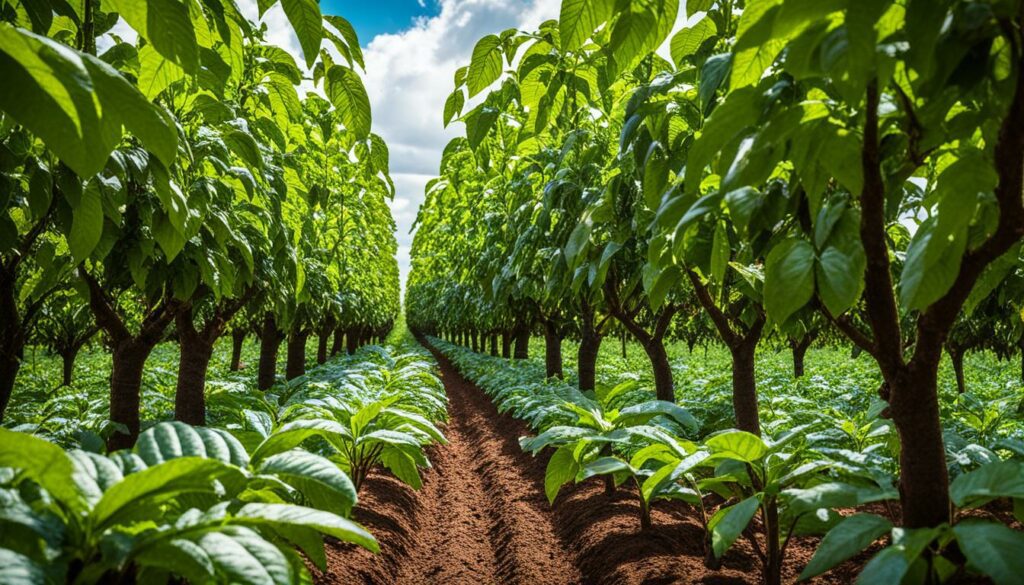
The GCFRP Program aims to keep forests, grow more cocoa, and better the community. It started in 2015 and ran until 2020, with a budget of USD 32.5 million. A key highlight was creating 85,000 hectares of protected forest, more than they aimed for.
Also, over 9,500 hectares of forests have been replanted, making cocoa farming greener. This effort was thanks to local people, who also enjoyed better lives and jobs. Nearly half of the people getting direct help from the project were women. This shows how fair the program is.
Farmers in the GCFRP Program have seen big improvements. They are getting more cocoa while being kinder to the planet. More than 800 farmers learned how to plant trees and manage their fields. This is making the land more fertile and keeps it healthy.
These steps are also fighting deforestation in Ghana, which is very urgent. They are making cocoa growing better for the farmers and the land at the same time.
| Key Metrics | Details |
|---|---|
| Total Budget | USD 32.5 million |
| Duration | 2015–2020 |
| Land Established as CREMAs | 85,000 hectares |
| Forest Area Restored | 9,500 hectares |
| Beneficiaries | 5,600 |
| Female Beneficiaries | 46% |
| Deforestation Rate Reduction | 2% per year |
The GCFRP Program and its climate-smart cocoa techniques have not just helped cocoa farming. They have made a pathway for a greener future. These stories of success show what is possible, and they inspire further steps in smart farming.
Ghana takes its cocoa farming seriously, aiming for a sustainable future. The nation is key in global cocoa supply, making its efforts vital. By focusing on green methods and helping local communities, Ghana’s path is clear.
The Cocoa Life project by Mondelēz International stands out. It’s already grown 1.3 million new trees. Their goal is to spend $400 million by 2022. This work benefits 200,000 cocoa farmers and a million community members, promoting growth all around.
In the past thirty years, Ghana’s cocoa output has greatly increased. This growth highlights the need for eco-friendly farming to ensure a bright future. The completion of the Cocoa Life project through the Global Cocoa Platform in 2020 is a significant step forward.
With initiatives like Cocoa Life, Ghana becomes a leader in sustainable cocoa farming. These actions push beyond only keeping up with cocoa demand. They also aim to set a standard for sustainable growth in farming.
Ghana is leading the way in responsible cocoa farming. It’s combining efforts to protect nature and support its economy through cocoa. This method lets the country keep its natural beauty and stand strong economically. Between January and September 2021, cocoa exports brought in $2.07 billion, making up nearly a quarter of all export earnings. This highlights cocoa’s key role in Ghana’s economy.
The Green Ghana Project has planted over forty million trees in just three years. This shows Ghana’s big push for more green areas and taking care of nature. The price given to cocoa producers has jumped by 63.5%, the biggest hike in half a century in West Africa. This move shows a strong focus on better pay for farmers. Together, these steps show Ghana is serious about using sustainable ways in farming, boosting the economy by 3%.
There have been major steps to improve farming and tracking information about where cocoa comes from. Nearly 348,000 farms have been mapped out with 85% of cocoa’s journey well tracked. Over four million trees were given out for planting in 2022 for better farming practices and to regrow forests. Training has been provided to more than 321,000 farmers, with over 163,000 learning about smart ways to grow cocoa. These efforts are key to fighting climate change and making sure cocoa farming lasts for the long term.
Ghana is really showing others how to make cocoa farming responsible. It has over five million smallholder farmers, and in teams with the Ivory Coast, they make most of the world’s cocoa. This shows the huge global impact of Ghana’s work. Ghana is working hard to keep cocoa farming going in a way that doesn’t harm the environment. This shows its strong commitment to balancing economics with taking care of nature.
Sustainable cocoa farming in Ghana means farming in ways that keep cocoa growing for a long time. It also tries to protect the environment. Farmers use shade trees, organic methods, and fair trade to do this. This helps both nature and the people who grow the cocoa.
Sustainable cocoa farming helps keep the soil rich and supports many plant and animal life. Ghana is a major cocoa producer. It must farm cocoa in ways that don’t harm the natural world. This is vital for the future of cocoa farming and the people who depend on it.
Many challenges face Ghanaian cocoa farmers, like cutting down trees, losing soil nutrients, and breaking up natural areas. These harms lower how much cocoa can be produced and hurt the environment where cocoa grows.
Deforestation in Ghana means breaking up the forests, losing wildlife pathways, and seeing fewer different plants and animals. This loss weakens the cocoa-growing lands. It makes the soil less good for cocoa and fewer cocoa seeds grow.
In Ghana, farmers are trying new things to grow coca better. They plant trees that make the soil better and trim cocoa trees in smart ways. It helps produce more cocoa. They also use organic ways to farm and keep their land healthy.
In Ghana’s cocoa business, important people are the government, local farmers, non-profit groups, and big companies like Mondelēz International. They work together to support farming that keeps going without harming the environment. They want farmers to do well and protect the land.
Losing paths for wildlife because of cutting down forests harms cocoa farming. This upsets the natural balance and can hurt cocoa growth. It might make cocoa farming hard to keep doing over time.
Ethical chocolate means chocolate that’s made fairly and doesn’t harm the environment. It makes sure farmers are paid fairly and they farm in ways that are good for nature. More people wanting ethically-made chocolate helps change how cocoa is grown.
The Ghanaian government supports cocoa that’s grown in ways that don’t harm the land. They help plant more trees, use more shade to grow cocoa, and support eco-friendly farming. Their efforts help keep farming cocoa possible in the future.
Organic cocoa beans sell for more and are good for the soil. Farming this way helps produce cocoa without using harmful chemicals. It helps the environment stay healthy and supports the local community.
The world’s demand for cocoa puts pressure on farmers to grow it in sustainable and forest-friendly ways. This makes companies look for cocoa that’s grown without hurting forests. It helps encourage cocoa farming that’s good for the planet.
Groups like the UNDP and companies like Mondelēz have projects to make farming better. Their work helps farmers grow cocoa without hurting the land. They also help farmers and their families do well.
Fair trade cocoa ensures farmers are treated and paid fairly. It encourages farming that is good for the earth. Buying fair trade chocolate helps farming communities and supports a better way to grow cocoa.
The Ghana Cocoa Forest REDD+ Program has been very successful. It helps farmers grow cocoa in ways that fight climate change. This work has made more cocoa while protecting the environment.
Ghana’s efforts in cocoa farming set an example for the whole world. They are using farming methods that are good for the environment. Ghana shows that it’s possible to farm cocoa without causing harm.